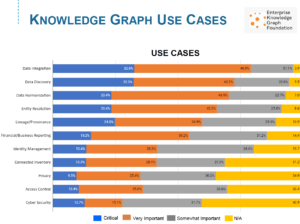By Monika Mueller
By now, you know what knowledge graphs are. They’re being used to optimize data by industry giants ranging from Microsoft, Amazon and Google to Airbnb, eBay and Comcast. But what about startups? And industries like manufacturing, biomedicine and beyond? These days, knowledge graphs have diverse uses — along with growing adoption across various industries, and companies of all size and scope. It’s safe to say that the genie is out of the bottle.
As Michael Atkin, co-founder of the Enterprise Knowledge Graph Foundation, told The Innovator, “We are seeing a dramatic increase in corporate use cases.” And it’s easy to see why. According to The Alan Turing Institute: Knowledge graphs organize data from varied sources, capture information about entities like people, places or events, and make accessible connections between them.
So what does that mean for you? It all translates to easier access to (and integration of) data, which according to Michael Atkin, “Gives corporates the ability to ask business questions and get business answers rather than focusing their energy on restructuring data and managing complex database joins.”
How Industries are Using Knowledge Graphs
Data presented at The Knowledge Graph Conference in 2021 detailed the following use cases for knowledge graphs:

Source: The Innovator, “New Report Details Industry’s Use of Knowledge Graphs,” May 7, 2021.
Let’s take a more granular look at how some industries are using knowledge graphs in very different ways.
How a Biomedical Disruptor Used Knowledge Graphs to Combat Covid
Founded in 2013, London-based BenevolentAI uses artificial intelligence to speed up drug discovery. In 2020, the company used its AI platform and biomedical knowledge graph to identify approved, safe drugs that could help treat COVID-19 by blocking the viral infection process. BenevolentAI identified baricitinib, an Eli Lilly drug used to treat rheumatoid arthritis, which led to clinical trials for the drug and ultimately FDA approval for COVID-19 treatment.
Using knowledge graph technology to visualize and explore the results, scientists made the initial discovery in just 48 hours. Trials proved baricitinib to be the most significant mortality reduction of any COVID-19 treatment at the time, reducing deaths by 38% among all patients, and 46% in ventilated patients. Read more about the case study here.
How Manufacturers are Using Knowledge Graphs
According to Ontotext, a company focused on AI strategy for enterprise clients, knowledge graphs can help manufacturers optimize incredibly complex production lines. In this context, a knowledge graph can serve as a digital twin of a machine, or the entire production facility, down to each component and its relationship to other components.
This allows knowledge graphs to help manufacturers with:
- Predictive maintenance
- Building automation
- Supply chain management
- Tracking standards
In essence, knowledge graphs can help manufacturers monitor various interconnected facets of their business. This visibility makes a complex web of systems more accessible and allows manufacturers to identify and solve for issues that may arise proactively in order to avoid downtime and keep production lines up and running.
How Knowledge Graphs Can Improve Communication and Collaboration
When used to analyze communication, knowledge graphs can have applications of a more interpersonal nature. For example, knowledge graphs can be used to analyze instant message conversations in order to improve collaboration, which is exactly what Neo4J did. The rapidly growing graph database platform created a knowledge graph to pull data from Slack — along with Google Drive and Salesforce — in order to improve remote collaboration.
With offices spread out geographically, the company faced challenges associated with rapid growth as new people joined, with new skills, new departments were added, and new product features developed. Neo4J used a knowledge graph to look at the questions their teams were asking over Slack, and found a lot of dialogue around inquiries like: Who has worked with this customer? Who has worked on this type of use case? Who has skills in the Amazon Cloud space? And many, many more.
The knowledge graph essentially helped the company capture information from Slack in order to understand who’s collaborating with who, and analyze the cohesion of virtual teams that exist across departments. Ultimately, Neo4J wanted to determine who is working where, and on what — in order to facilitate peer-to-peer access to individuals’ expertise. Hear more about the project details in this YouTube webinar.
The Future of Knowledge Graphs
As the use cases of knowledge graphs continue to evolve, the diverse capabilities of the technology will only gain a wider audience that ultimately accelerates adoption. How does your organization use knowledge graphs? We’d love to hear from you as we continue to explore this leading edge technology.
